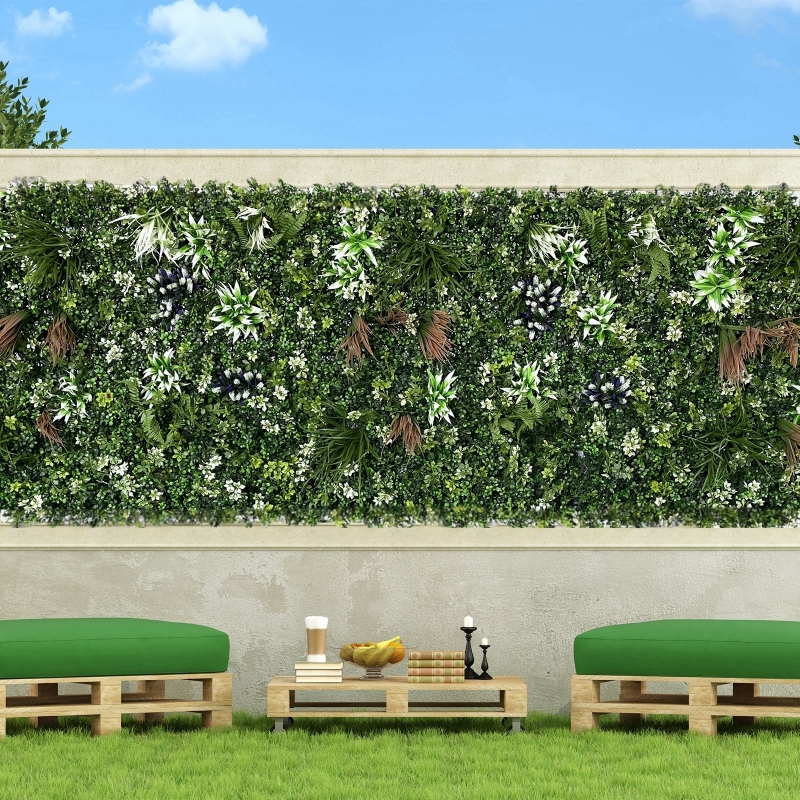Tropical Plant Applications in 3D Artificial Vertical Gardens: Designing Lush, Exotic Green Walls
Tropical plants bring bold textures, vibrant colors, and a sense of escapism to 3D artificial vertical gardens. Their dramatic foliage and striking forms can transform ordinary spaces into tropical paradises, even in climates where real tropical species cannot thrive. Below are strategies for incorporating artificial tropical plants into vertical gardens for maximum visual impact.

Artificial tropical plants come in a wide range of forms, from broad-leaved giants to delicate, fern-like fronds. Choosing the right mix ensures a dynamic, layered appearance.
Large, Bold-Leaved Plants: Use artificial elephant ear leaves, monstera, or philodendron to create focal points. Their oversized foliage adds drama and serves as a backdrop for smaller plants. Position these in central panels or areas with recessed depths to emphasize their scale.
Delicate, Airy Ferns: Incorporate artificial staghorn ferns, bird’s nest ferns, or Boston ferns to soften transitions between bolder elements. Their feathery texture contrasts with heavier leaves, adding balance and movement.
Spiky or Architectural Accents: Introduce plants with striking shapes, such as artificial snake plants, yucca, or bromeliads, to break up rounded forms. These accents add visual interest and mimic the diversity of tropical ecosystems.
Vertical gardens thrive on dimensionality, and artificial tropical plants can be strategically placed to enhance this effect. Layering mimics the way plants grow in dense rainforests, adding realism and complexity.
Foreground, Midground, and Background Separation: Place shorter, more detailed plants like artificial calathea or prayer plants in the foreground, medium-height varieties like ferns in the middle, and taller, bolder forms like elephant ears in the background. This technique creates an illusion of distance, even in compact spaces.
Overlapping Foliage: Allow some plants to “spill” over the edges of panels or overlap with neighboring species. This mimics the organic spread of real tropical plants and adds a sense of abundance.
Vertical Spacing for Airflow: Leave small gaps between plant clusters to prevent visual clutter and ensure the garden doesn’t appear overly dense. In artificial designs, these gaps also reduce dust accumulation and simplify cleaning.
While many tropical plants are known for their deep greens, artificial versions offer endless color possibilities. Thoughtful color pairing enhances the garden’s overall impact.
Monochromatic Green Schemes: Use varying shades of green—from lime to emerald to forest—to create a lush, cohesive look. This approach works well in modern or minimalist spaces where subtlety is key.
Bold Accents with Variegation: Incorporate artificial tropical plants with variegated leaves, such as those mimicking calathea or croton, to add visual excitement. Place these near solid-green plants to create contrast and draw the eye.
Pop of Color with Flowering Plants: Introduce artificial tropical flowers like hibiscus, bird-of-paradise, or orchids in vibrant reds, pinks, or yellows. Use these sparingly to highlight focal points or add a festive touch.
Even artificial tropical plants benefit from arrangements that replicate how they grow in the wild. This authenticity makes the garden feel intentional rather than artificial.
Clustering by Species: Group similar plants together, as they would naturally form colonies in rainforests or jungles. For example, place several artificial monstera plants in a tight cluster to mimic their real-life behavior.
Asymmetrical Balance: Avoid perfectly symmetrical layouts, which can look stiff. Instead, offset larger plants with smaller ones and vary their orientations to create a more organic, flowing feel.
Incorporating “Vining” Elements: Use artificial vines like pothos or philodendron to trail down panels or wrap around supports. These details mimic the climbing habits of real tropical plants and add a sense of movement.
By focusing on variety selection, layered arrangement, color coordination, and natural growth patterns, artificial tropical plants can transform 3D vertical gardens into vibrant, exotic oases. Their durability and low-maintenance nature make them ideal for a wide range of applications, from residential patios to commercial atriums, where they provide lasting beauty without the need for watering, pruning, or pest control.
Contact: Amy
Phone: 86-15311787313
E-mail: info@foszmac.com
Whatsapp:86-15311787313
Add: Fengtai District, Dacheng Road, No.24 Building, Room 203, Beijing, China